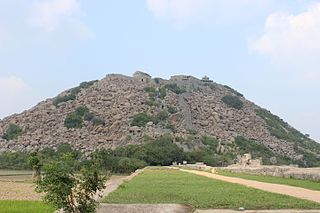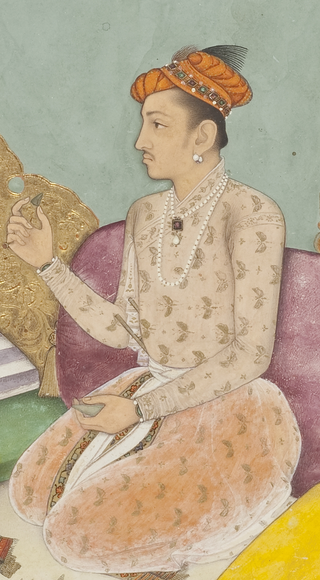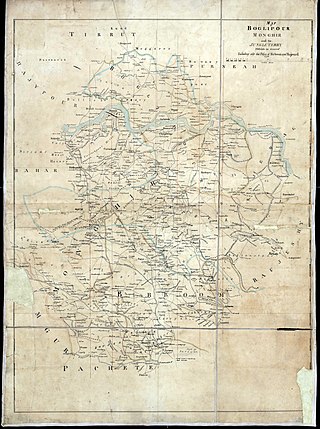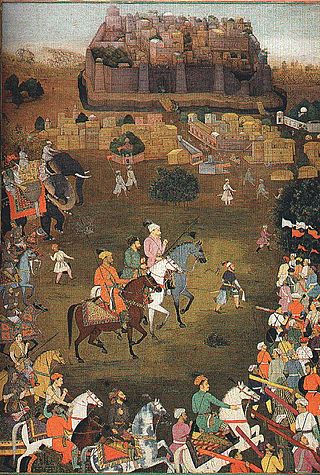Raja Desingh or Raja Tej Singh was a king of the Bundela Rajput who ruled Gingee in 1714 CE.
Raja Desingh or Raja Tej Singh was a king of the Bundela Rajput who ruled Gingee in 1714 CE.
The Mughal Empire defeated the Maratha Empire at Gingee in February 1698. [1] [ unreliable source? ]
In return for military services, [2] the Mughal Emperor Aurangzeb, granted a mansab rank of 2,500 and jagir land grant of 12 lakhs (1,200,000) to Raja Swarup Singh, a Bundela Rajput chieftain, along with the kiladari (fort commandership) of Gingee in 1700 AD. Raja Swarup Singh died of old age in 1714 AD. Hearing about the death of his father, Desingh, the newly married son of Raja Swarup Singh, started for Gingee from Bundelkhand, his ancestral home. Differing accounts have the Nawab of Arcot, Saadatullah Khan I somewhat recalcitrant to the Mughal Empire, [3] [ unreliable source? ] and the terms of the grant from Aurangzeb were disputed, nevertheless a debt was claimed after Aurangzeb's death ... a debt that the Raja refused to pay, eventually the arrears of payments due amounted to 70 lakhs rupees (7 million), and being a defaulter for ten years; the Nawab of Arcot reported this matter to the Mughal Emperor at the time, Bahadur Shah I at Delhi. . [4]
Traditional plays and ballads are sung in and around Gingee about the gallantry displayed by Desingh at the young age of 22, against the more powerful Nawab Sadatulla Khan of Arcot in a struggle that was unmatched from the outset (Desingh’s army consisted of only 350 horses and 500 troopers, while the Nawab’s army had 8,000 horsemen and 10,000 sepoys). Desingh eventually died in battle and his small army was defeated. His young wife committed Sati on his funeral pyre. [3] [ unreliable source? ] However, the fortress of Gingee lost its pre-eminent position and political importance within a few years of the extinction of the Rajput rule.

Ajit Singh Rathore was the ruler of Marwar region in the present-day Rajasthan and the son of Jaswant Singh Rathore.

Gingee Fort or Senji Fort in Tamil Nadu, India is one of the surviving forts in Tamil Nadu, India. It lies in Villupuram District, 160 kilometres (99 mi) from the state capital, Chennai, and is close to the Union Territory of Puducherry. The site is so fortified that Shivaji, the Maratha king, ranked it as the "most impregnable fortress in India", and it was called the "Troy of the East" by the British. The nearest town with a railway station is Tindivanam and the nearest airport is Chennai (Madras), located 150 kilometres (93 mi) away.

Gingee, also known as Senji or Jinji and originally called Singapuri, is a panchayat town in Viluppuram district in the Indian state of Tamil Nadu. Gingee is located between three hills covering a perimeter of 3 km, and lies west of the Sankaraparani River.

The Carnatic Sultanate was a kingdom in South India between about 1690 and 1855, and was under the legal purview of the Nizam of Hyderabad, until their demise. They initially had their capital at Arcot in the present-day Indian state of Tamil Nadu. Their rule is an important period in the history of the Carnatic and Coromandel Coast regions, in which the Mughal Empire gave way to the rising influence of the Maratha Empire, and later the emergence of the British Raj.

Mirza Raja Jai Singh I was the senior most general and a high ranking mansabdar at the imperial court of Mughal Empire as well as the Kachwaha ruler of the Kingdom of Amber. His predecessor was his grand uncle, Mirza Raja Bhau Singh,the younger son of Mirza Raja Man Singh I

The Kingdom of Mewar, sometimes known as Udaipur State, was an independent kingdom in Rajputana region of India, ruled by the Sisodia dynasty. It was established around the 6th century by the minor rulers of the Nagada-Ahar region of Udaipur and later, in the 10th century, it transformed into an independent state under Rawal Bharttripatta II.

Kingdom of Marwar, also known as the Jodhpur State under the British, was a kingdom in the Marwar region from 1243 to 1818 and a princely state under British rule from 1818 to 1947. It was established in Pali by Rao Siha, possibly a migrant Gahadavala noble, in 1243. His successors continued to struggle against regional powers for domination and 9 out of 15 rulers till 1438 died in combat. In 1395, its capital was changed to Mandore by Rao Chunda of Mandore and to Jodhpur in 1459 by Rao Jodha.

Raja Desingu is a 1960 Indian Tamil-language biographical film starring M. G. Ramachandran, S. S. Rajendran, Bhanumathi and Padmini. Based on the life of Desingh, the film was directed by T. R. Raghunath and had a delayed release on 2 September 1960.

The siege of Jinji,, began when the Mughal Emperor Aurangzeb appointed Zulfiqar Ali Khan as the Nawab of the Carnatic and dispatched him to besiege and capture Jinji Fort, which had been sacked and captured by Maratha Empire troops led by Rajaram, they had also ambushed and killed about 300 Mughal Sowars in the Carnatic. The Mughal Emperor Aurangzeb then ordered Ghazi ud-Din Khan Feroze Jung I to protect the supply routes leading to Jinji Fort and to support and provide reinforcements to Zulfiqar Ali Khan when needed.
The Mughal–Rajput Wars were a series of battles fought between the Rajput Confederacy and the Mughal Empire which started with the Timurid ruler Babur's invasion of northwestern India and the head of the Rajput confederacy Rana Sanga's resistance to it.
The Battle of Jajau was fought between the two Mughal princes and brothers Bahadur Shah I and Muhammad Azam Shah on 20 June 1707. In 1707, their father Aurangzeb died without having declared a successor; instead leaving a will in which he instructed his sons to divide the empire between themselves. Their failure to reach a satisfactory agreement led to a military conflict. After Azam Shah and his three sons were killed in the Battle of Jajau, Bahadur Shah I was crowned as the Mughal emperor on 19 June 1707 at the age of 63.
Events in the year 1707 in India.

The Senji Singavaram Ranganatha Temple is a cave-temple in India dedicated to God Ranganatha and Goddess Ranganayaki Thayar. The temple is a Pallava period structure, and was reconstructed and patronized by Krishnapa Nayakkar of Senji Nayak dynasty..
Raja Swarup Singh Bundela was the fort commander of Gingee Fort in Tamil Nadu, India from 1700 until his death in 1714.

Kharagpur Raj was a prominent chieftaincy, founded in the early 16th century in Bihar situated mainly in modern-day Munger district. They were notable for being one of the few chieftaincies in Bihar to convert to Islam and many of the rulers became firm allies of the Mughal authorities. At its peak, the Kharagpur Raj encompassed parts of the modern-day districts of Munger, Bhagalpur, Jamui, Lakhisarai, Godda and Deoghar. Due to its size, the Privy Council compared it with the Kingdom of Sardinia.

The Rajput rebellion began in 1708, due to the harsh treatment of the Rajput Rajas by the Mughal emperor. It erupted into a two-year rebellion that forced the Mughal emperor to sue for peace, give them gifts, and restore the Rajput holdings which had been annexed by the previous Mughal emperor Aurangzeb.
The battle of Dharmat was fought during the Mughal War of Succession (1658–1659) by Aurangzeb against Jaswant Singh Rathore who was allied with the Mughal prince Dara Shikoh. The battle was fought on the open plain of Dharmat on the hot Summer day of 15th April 1658 in which Aurangzeb won a decisive victory due to advantage in artillery and tactics.
After the mid-16th century, many Rajput rulers formed close ties with the Mughal emperors and served them in various capacities. It was because of the Rajputs that Mughals were not able to conquer whole India. The vassals had their daughters and sisters married to the Mughal emperors and their princes. The successors of the Mughal emperor Akbar, the mothers of his son Jahangir and grandson Shah Jahan were Rajputs. The Sisodia Rajput family of Mewar made it an honor not to enter into matrimonial relations with the Mughals, and thus stood in contrast to all other Rajput clans. After this time, the marital relations between the Rajputs and the Mughals declined somewhat. Akbar's relations with the Rajputs began when he returned in 1561 from a visit by the Chisti Sufi Shaikh of Sikri, west of Agra. Then many Rajput princesses married Mughal emperor Akbar.

The siege of Orchha was a military expedition of Mughal empire under Aurangzeb aganist rebellious Bundela Rajputs under Jhuhar Singh.The Mughal army captured the Bundela capital during the combined siege of Orchha, on October 4, 1635. Aurangzeb raised the Mughal flag on the highest terrace of the Jahangir Mahal and installed Devi Singh as the new administrator, while Jhujhar Singh escaped.
{{cite web}}: CS1 maint: archived copy as title (link)